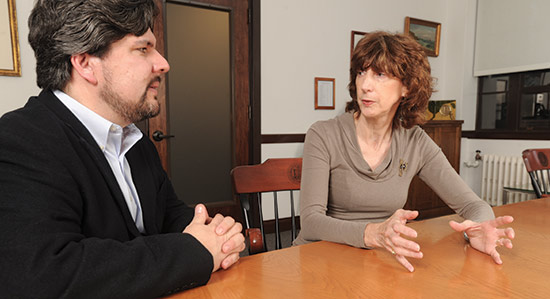Q+A on excellence and diversity
Last fall a national study* reported that women in engineering left the field more often than men. Meanwhile, women and ethnic minorities continue to compose a fraction of the enrollment at the nation’s top engineering schools. Berkeley Engineering counters these trends with K–12 outreach like Computer Science Education Day and the student-run Berkeley Engineers and Mentors program. Now, the college is expanding its efforts to attract a diverse range of highly qualified students to engineering. One initial step is the January 2012 appointment of materials scientist Oscar Dubón as associate dean for equity and inclusion. Berkeley Engineer sat down with him and Executive Associate Dean Fiona Doyle to learn more
 Oscar Dubón and Fiona Doyle (Photo by Noah Berger)What are the numbers?
Oscar Dubón and Fiona Doyle (Photo by Noah Berger)What are the numbers?
Doyle: We have come a long way in my 29 years on the engineering faculty. Women make up nearly a quarter of our undergraduate body overall. This is better than the national average of 17 percent, but there is still work to be done.
Dubón: Underrepresented minorities made up just 6 percent of our undergraduate and graduate student body in 2011. Many applicants tell us they would love to come to Berkeley but are able to secure better financial support from our private peers. Improving access with increased scholarship and fellowship funding will be key to our success.
The study cites confidence issues among women that may hinder retention.
Doyle: I really don’t see this as a major factor at Berkeley Engineering. Over the last couple of decades, I’ve seen a huge increase in the self-confidence of our women. Also, in contrast to national trends, our retention of women students from year to year is actually higher across each department than it is for men, and graduation rates are indistinguishable by gender. Half the leaders in our student organizations are women—far higher than their proportion overall—and they on excellence in diversity are well-respected by their peers, men and women.
Specifically, the study measured the sense of professional “fit.”
Dubón: My father, who emigrated here from Nicaragua, came to California to become a civil engineer and inspired my sister and me to become engineers as well. However, most of my classmates, who did not have such a role model, elected not to pursue STEM-related careers. So we must engage our young talent in order to expand the pipeline of well-prepared, diverse students who excel in math and science.
What can be done to welcome more women and underrepresented minorities?
Doyle: Our “Excellence in Diversity” strategy focuses on leadership development, professional advising, research opportunities from the undergraduate level on up and support for more than 50 student organizations, including many multicultural groups and honor societies. We live in an interconnected world, and we need to create a diverse learning environment that all of our students can thrive in together.
* “Professional Role Confidence and Gendered Persistence in Engineering,” American Sociological Review, October 2011

